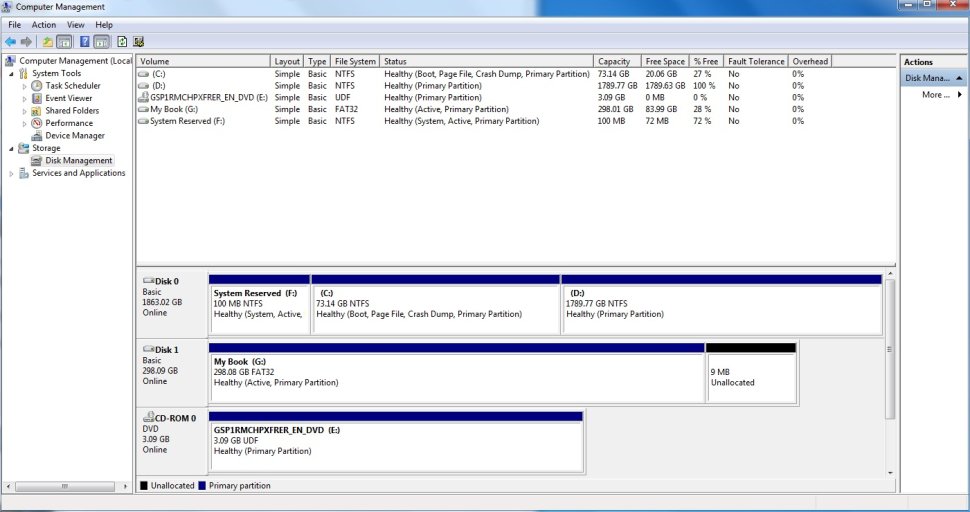I myself forgot what all the steps I did to get where I'm at now are exactly, but I'll try from memory:
But what started all this is I only had one HDD and one OS (Win7) installed on it. I installed EasyBCD 2.1.2 and added a Win7 entry to the boot menu (doesn't matter that it was a stupid choice, just that I did it). But when I clicked on "Add Entry" nothing seemed to happen, so I did it again, same response. I exited the program and it prompted me with something like "If you exit you will not be able to boot anything". I didn't think much of it basically, and rebooted. I was granted with three options to boot from (not verbatim):
1. Windows 7 Home Edition;
2. Microsoft Windows 7;
and 3. Microsoft Windows 7.
I surmised that the latter two were created in EasyBCD. If I chose either of the two EasyBCD created, it would do a quiet reboot, no errors or anything. When I booted from the first option, it would give me a message to the tune of "Select proper boot device; insert proper boot media".
I frantically thought to myself various things, and began to reinstall Windows 7 after much meditation, erased the whole HDD and started fresh (all my beautiful data gone; a humbling experience, again whether or not I should have done that doesn't matter, just that I did) It installed fine, logged on, installed some drivers, rebooted. Same error message, but this time no choice of OS, just that message. I thought maybe I fiddled with the boot order, so I checked it and all was fine, aside from one detail: there used to be "Windows Boot Manager" I could choose to boot from, which was what it was always set to boot to first, not my HDD. I believe the order ORIGINALLY was:
(Note: I don't remember which choices had "(UEFI)" after them, but I'm sure I remembered at least one of them used to, possibly the "Windows Boot Manager")
1. Windows Boot Manager
2. HHD at location 0
3. DVD at location 1
But NOW it looked something like this:
1. HDD at location 0
2. DVD at location 1
I didn't know what to do, so I installed Win 7 yet again, this time staying on and not rebooting. This time, I believe, is where I found this forum and posted (also posted on another to no avail). I read through and tried, eventually,
all six of these possibilities, and none of them worked. I then began to fret very much and lose much of my morale. I did notice though, through these steps, that the only possibly way that I found out to be able to boot my OS, is to have the Win 7 installation DVD in my DVD drive while I was booting. It would read the disc and say "Press any key to boot from DVD" but I wouldn't, and Windows would boot successfully.
That is pretty much where I'm at now. I tried a variety of my own permutations and takes on the Windows bootrec, bootsect, and bcdedit commands, all to no avail. But I'm still able to boot with the DVD in the drive (this only beings me a quasi bit of comfort).
The really odd thing to me was when I removed this HDD, put in a completely different HDD, and installed Ubuntu 10.10 on it. It installed fine, I fiddled around trying to get my graphics drivers installed, then rebooted. The same error occurred. At this point I started thinking very bad thoughts, I will not be explicit in their detail, for they were not for the faint of constitution. It was at this point I decided to, because things weren't making any sense to me whatsoever, put in the Windows 7 disc in the DVD drive as I booted Ubuntu. It worked just like it did with Windows 7.
I am here now, asking for help hoping I don't have to get a new motherboard, given I flashed an older BIOS and it didn't help, and then flashed the then current BIOS and it didn't help either. I'm also studying the bcdedit command very thoroughly to try something perhaps I didn;t try before. I didn't clear the CMOS, but I did read about VRAM (which was described as "non volatile", which I think means it stores itself there, even after a reboot or something) in the motherboard storing information about the bcd or something, thinking maybe clearing it could help as a last resort. I don't want to be taboo here or be offensive in any way, but maybe another software could fix what EasyBCD did somehow? I'm running out of ideas.
Addendum:
Thanks for sticking with me, by the way.

